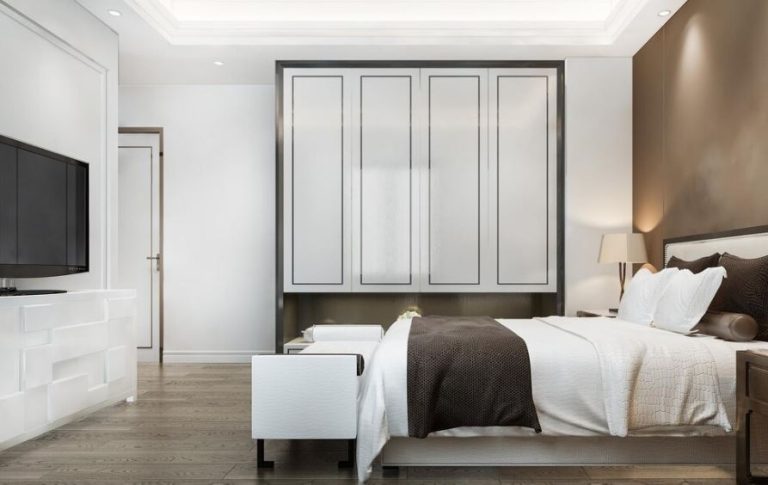The master bedroom subtly regained its position as the emotional hub of the home as our houses transformed into all-in-one retreats, offices, and havens in recent years. In contrast to the commotion of kitchens or the theatrical elegance of living rooms, your bedroom is still a private sanctuary that is sacred, intimate, and intensely personal.
Making a deliberate investment in this area goes beyond simply changing the colors or furniture. How you begin and end each day is something you actively control. That change can be incredibly beneficial for improving sleep, increasing focus, and even resetting emotional energy—especially if it’s in line with your unique rhythms.
Master Bedroom Makeover Ideas: WordPress-Ready Information Table
| Feature | Description |
|---|---|
| Purpose of Redesign | Improve emotional wellness, enhance sleep quality, create personal sanctuary |
| Trending Themes in 2025 | Biophilic design, smart lighting, moody neutrals, personalized minimalism |
| Cost Estimate | DIY starts around $500; full redesigns can range $5,000–$15,000 depending on scale |
| Popular Color Trends | Deep navy, olive green, muted clay, soft ivory, serene taupe |
| High-Demand Materials | Velvet, linen, reclaimed wood, stone textures, boucle |
| Smart Integration | Ambient lighting systems, automated blinds, app-connected HVAC, smart beds |
| Storage Solutions | Under-bed drawers, built-in headboards, floating nightstands, custom wardrobes |
| Health & Sleep Benefits | Improved circadian rhythm, lower stress levels, more restorative rest |
A Reset Button—Not Just a Room
Most people have already put up with more chaos than they ought to by the time they think about redesigning their bedrooms. Dim lighting, outdated nightstands, or bedding that has lost its softness over time. It makes sense, but it’s no longer required.
The difficulty for mid-sized homeowners frequently resides in striking a balance between practicality and personal preference. Even without a bay window or a vaulted ceiling, you can create a space that exudes calm and style by layering lighting, selecting soothing colors, and curating textures. It’s amazing how minor adjustments can have a significant emotional impact.
Creating for Your Emotions, Not Just Your Appearance
It’s easy to put Instagram-worthy aesthetics first. However, knowing how a space feels is the first step toward real transformation. We are reminded that emotions are more important than fashion by Katie Hodges, who transformed her master bedroom in the Hollywood Hills to resemble an opulent Italian hotel.
Her use of saffron and butterscotch, luxurious bedding, and antique accents resulted in a room that was as visually elegant as it was emotionally reassuring. Comforting, inspiring, and gently guiding your emotions through your surroundings is the essence of design.
When Paint Is Not as Strong as Texture
Texture serves as an enticing whisper in the realm of master bedroom makeover ideas. Each piece of furniture—a wool throw, a linen drapery, or a tufted velvet headboard—speaks subtly but effectively. When redesigning a condo in San Francisco, designer Linda Hayslett stated that she wanted the bed to “engulf you.” She was successful in creating a cocooned space with curved silhouettes and tactile materials.
Even though they are subtle, these factors gradually gain emotional weight. Like a hug from a longtime friend or your favorite sweater, they grow comfortable and familiar.
Big Dreams, Little Bedrooms
Let’s talk about a shared issue: space. It is a common misconception that spaciousness and luxury are synonymous, but this is untrue. The work of Michael Chen on a small apartment in Manhattan shows otherwise. He installed floating shelves, a chic Murphy bed, and well-placed mirrors to create a room that felt roomy, light, and incredibly practical.
Even the smallest spaces can seem spacious thanks to careful design. Verticality, creative storage, and choosing fewer but more purposeful furnishings are the keys.
Intelligent Bedrooms’ Ascent
Technology is no longer confined to media rooms and kitchens in the context of contemporary living. It’s moving into bedrooms, and this migration is intentional. You’re investing in your health rather than just enjoying luxury when you incorporate smart lighting that adapts to your sleep cycle or a mattress that tracks REM patterns.
App-synced thermostats, noise-absorbing design elements, and blackout automation are now common features of smart bedrooms, as seen in HGTV’s 2025 Dream Home. These developments are incredibly successful in promoting restful sleep and minimizing disturbances during the night.
Using Color to Tell Stories
Color has emotional significance. It narrates tales of your identity and desires. Muted greens, earthy browns, and dusty blues will be the most popular colors in the upcoming years, reflecting our shared desire for a sense of groundedness.
“Colors that mimic natural landscapes evoke peace and calm in the subconscious mind,” says design psychologist Sally Augustin. This has scientific backing and isn’t just a mood enhancer. In fact, a soft ivory bedspread or a muted green wall can help reduce anxiety and tell your brain to slow down.
Adding Value Without Remodeling
What happens if you don’t have enough money for designer consultations or new construction? You’re not in a bad situation or alone. Begin modestly. The space can be redefined with a window seat, a throw blanket, and a warm lamp. Replace overhead lighting with more intimate pendant fixtures. Swap out your worn-out pillows for ones that are tactile.
The room starts to change with little deliberate changes. You’ll also notice that you breathe a little deeper at night and that you feel different when you wake up.
Architecture of Emotion
Every component of your bedroom contributes to the peaceful architecture. Not only your windows and walls, but also your bookshelf, lighting, curtains, and even the sound your feet make on the rug. Your body’s relaxation and mental state can be influenced by this emotional architecture.
Your bedroom becomes more than just a space when it’s done correctly. Like a well-balanced soundtrack or a favorite fragrance, it turns into an experience. That is the real impact that a bedroom makeover can have. It is more than just aesthetically pleasing. It cures the soul.
FAQs
What’s the easiest way to start a master bedroom makeover?
Begin with lighting, bedding, or wall color. Small changes create big impact.
How much should I budget for a master bedroom makeover?
You can start with $500 for a light refresh or spend $10K+ for luxury upgrades.
What colors are trending in master bedroom makeovers?
Moss green, sandy beige, navy blue, and soft clay tones are 2025’s favorites.
Can tech really improve my sleep environment?
Yes. Smart lighting and climate control systems align with your natural rhythm.
Do I need a designer to makeover my master bedroom?
Not always. With inspiration from reliable sources, DIY is totally achievable.


